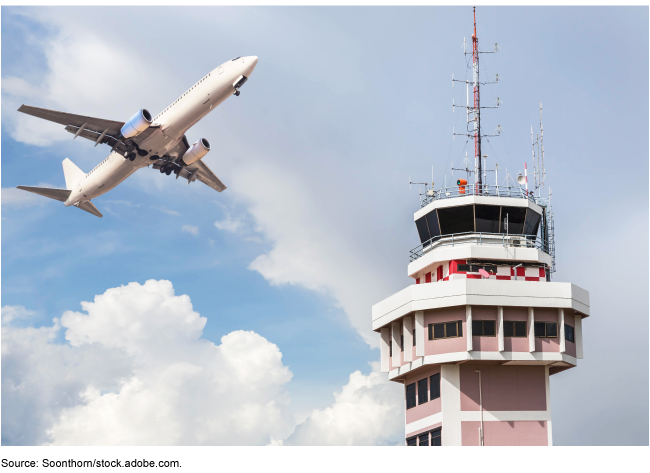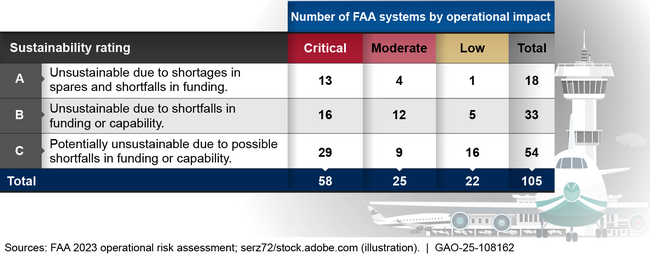Air Traffic Control: FAA Actions Urgently Needed to Modernize Systems
Fast Facts
Air traffic controllers rely on numerous complex systems to manage 45,000 flights per day in the national airspace. These systems allow air traffic controllers to track and sequence flights, communicate with pilots, and more.
We testified on the Federal Aviation Administration's reliance on numerous aging and unsustainable air traffic control systems. We also discussed the mixed progress FAA has made with implementing its multi-decade modernization effort, known as NextGen.
We urged FAA to act on 9 prior recommendations it has not yet addressed. Doing so can help FAA manage risks and improve modernization efforts.

Highlights
What GAO Found
A shutdown of the national airspace in 2023 due to the outage of an aging air traffic control (ATC) system prompted the Federal Aviation Administration (FAA) to conduct an operational risk assessment to evaluate the sustainability of all ATC systems. Of the 138 systems, 51 (37 percent) were deemed unsustainable by FAA and 54 (39 percent) were potentially unsustainable. Many unsustainable and potentially unsustainable systems have critical operational impacts on the safety and efficiency of the national airspace. In September 2024, GAO found several weaknesses in how FAA manages investments to modernize these systems. FAA's progress has also been slow, taking years to establish cost, schedule, and performance baselines for investments that GAO selected for its review. As of May 2024, completion dates for planned investments for systems that GAO deemed especially concerning were at least 6 to 10 years away. Four such systems did not have associated investments.
Air Traffic Control (ATC) System Sustainability and Operational Impact Ratings

A November 2023 GAO report found that since 2018, FAA had made mixed progress on its multi-decade effort to modernize air traffic management (i.e., the Next Generation Air Transportation System (NextGen)). Across four critical program areas GAO assessed (e.g., navigation and communications), FAA met some milestones for deploying systems but missed others, some by several years. The COVID-19 pandemic, which delayed system testing and other activities, contributed to those missed milestones. GAO found that closer adherence to five of nine program management leading practices, such as those related to life-cycle cost estimates and risk mitigation strategies, could better position FAA to manage the program and realize safety and efficiency benefits.
GAO's 2023 and 2024 reports made recommendations to FAA to help address shortcomings in the agency's management of NextGen and ATC system investments. For example, weaknesses exist in FAA's risk mitigation approach. GAO recommended FAA develop a risk mitigation plan for NextGen and report to Congress on its risk mitigation efforts for all unsustainable and critical systems. Doing so would help FAA systematically examine risk mitigation options and increase transparency. FAA has fully addressed two GAO recommendations: conducting root cause analysis on programs that exceed baselines and managing investments in segments. However, critical risk mitigation recommendations and others remain open.
Why GAO Did This Study
FAA is responsible for the safety and efficiency of more than 45,000 flights daily. Critical to that effort are numerous ATC systems that enable air traffic controllers to monitor weather, conduct navigation and surveillance, manage communications, and more. However, ATC systems have been aging, and GAO has long reported that FAA has faced challenges upgrading those systems and implementing its multi-billion-dollar modernization of air traffic management, referred to as NextGen. Addressing these challenges is particularly important given that FAA expects to manage an increasingly congested and complex airspace in the future.
This testimony discusses (1) the sustainability of FAA's air traffic control systems, and FAA's efforts to manage and oversee system modernization; (2) FAA's efforts to implement NextGen; and (3) actions needed for improvement. It draws primarily from GAO's September 2024 report on unsustainable ATC systems and November 2023 report on NextGen.
Recommendations
GAO made nine recommendations to FAA that remain open. These include actions to improve oversight, project baselining, and adherence to program management leading practices. Urgent attention is needed to fully address these and the other remaining recommendations.
